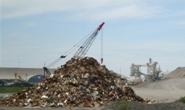Prices

September 5, 2013
Scrap Prices Weakening as Week Progresses
Written by John Packard
Final Scrap Pricing Settlement Numbers Still in Negotiation
Scrap prices continued their weakening trend – especially on shredded with cut grades such as #1 HMS and prime grades such as #1 busheling are moving sideways to down $10 depending on the geographical location and the status of the mills in each area. We heard from a Chicago area dealer that all three grades (HMS, shred and busheling) were sold down $10 per gross ton. This is most likely due to the #3 furnace having been offline at Indiana Harbor and now ArcelorMittal is taking a blast furnace down at Cleveland.
We understand from our sources that scrap sales in the Detroit and southern USA markets are down $10 on shredded and we are hearing lower numbers also on cut grades and busheling compared to the beginning of August sales numbers. However, there have been resistance to the offers being made and the final settlement numbers have not yet been concluded.
From the east we heard from one of our scrap sources:
Mid-Atlantic prices are generally sideways for cut grades, and maybe down $5/GT on shred. The south started out about sideways to down $5/GT on shred but now seems to be trending down $10/GT. The OH Valley is clearly the weakest region with shred down $10-20/GT. We are seeing shred prices there at $350-60/GT for September. There is a real lack of demand this month in the Valley because of Mittal Cleveland’s BOF outage, Republic’s recent electric problems, and weak buying programs at V&M and AK Butler. That reduced scrap demand and consequent improved supply of shred is probably a temporary situation – it may last 30-60 days – but I expect it to correct by the end of October as dealers prepare for winter and lower buying prices will have taken their toll on inflows by that time.
There are some varying factors regarding export. Trading activity in recent weeks has been lacking but prices have not moved much. Expectations in the near term are for prices to decline a bit (say $10-$15) but then trend upwards as we get toward the end of the year. Lower US domestic prices and of course the instability of the MENA region are impacting buying appetites. But if we are really seeing some stability in the Eurozone economy (at least it not getting worse), that should bode well for Turkish and North African end product demand and keep some scrap in Europe rather than it being available for export.
Prime grades remain relatively tight though I would imagine that they will settle down from higher recent levels due to downward pressure on the obsolete grades.
From a New York based shredding company we were told they sold 55,000 gross tons of shredded late this morning at down $11 per gross ton.
Scrap Prices Could be Range-Bound Through the End of the Year
One of the large national scrap companies with locations around the U.S. told us in an email:
The market has been transacting at down $10-15/GT but will likely continue to soften as the week progresses. Scrap supply seems to be ample as domestic buyers continue to take advantage of weaker export numbers. If the dollar continues to strengthen and deep sea freight rates increase, additional downward pressure may persist. Conversely, if mill operating rates, ore/metallics prices remain stable, and Q4 steel destocking is limited, a case could be made for a range-bound finished through year end. Finally, the spread between prime and obsolete scrap bears watching if we see EAF operating rates decline and Nucor’s DRI production ramps up, providing additional Fe units to the market in Q4.







